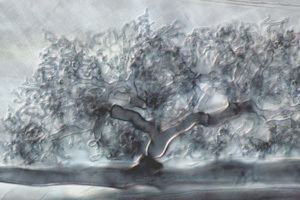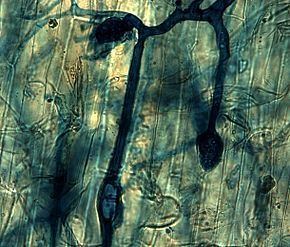Kingdom Fungi | Scientific name Glomus intraradices Rank Species | |
 | ||
Similar Glomus, Glomeromycota, Medicago truncatula, Acaulospora, Glomerales | ||
rhizophagus irregularis
Rhizophagus irregularis (previously known as Glomus intraradices) is an arbuscular mycorrhizal fungus used as a soil inoculant in agriculture and horticulture. In addition, it is one of the best mycorrhizal varieties of fungi available to mycoforestry, but it does not produce fruiting bodies such as mushrooms so "has virtually no market value as an edible or medicinal mushroom"
Contents
- rhizophagus irregularis
- Description
- Identification
- Reproduction
- Distribution
- Conservation and status
- Relevance
- References
Rhizophagus irregularis is also commonly used in scientific studies of the effects of arbuscular mycorrhizal fungi on plant and soil improvement.
Recent molecular analysis of Ribosomal DNA suggested that Glomus intraradices is not in fact in the genus Glomus at all, and should be renamed Rhizophagus intraradices.

Description
Identification

Rhizophagus irregularis colonization peaks earlier than many of the other fungi in the Glomus genus. There tends to be extensive hyphal networking and intense intraradical spores associated with older roots of host plants.

At times the spores are densely clustered or patchily distributed, depending on the host species. When the spores are heavily clustered, mycorrhizologists and others will tend to mistake G. intraradices for G. fasciculatum.
Reproduction

Rhizophagus irregularis (previously known as Glomus intraradices) has been found to colonise new plants by means of spores, hyphae or fragments of roots colonised by the fungus
Distribution
Rhizophagus irregularis can be found in almost all soils, especially those populated with common host plants and in forests and grasslands.
This is a brief list of some common host plants. Most agricultural crops will benefit from Rhizophagus irregularis inoculation. Generally host plants must be vascular plants, but not always.
Conservation and status
Rhizophagus irregularis is not in danger of becoming extinct; however, most damage is caused by chemicals and tillage.
Relevance
In numerous scientific studies G. intraradices has been shown to increase phosphorus uptake in multiple plants as well as improve soil aggregation due to hyphae.
Because of these qualities, G. intraradices is commonly found in mycorrhizal based fertilizers.
In a recent study, G. intraradices was found to be the only arbuscular mycorrhizal fungi that was able to control nutrient uptake amounts by individual hyphae depending on differing phosphorus levels in the surrounding soil.
